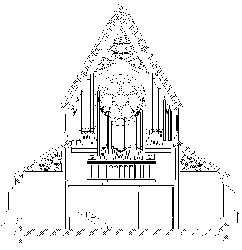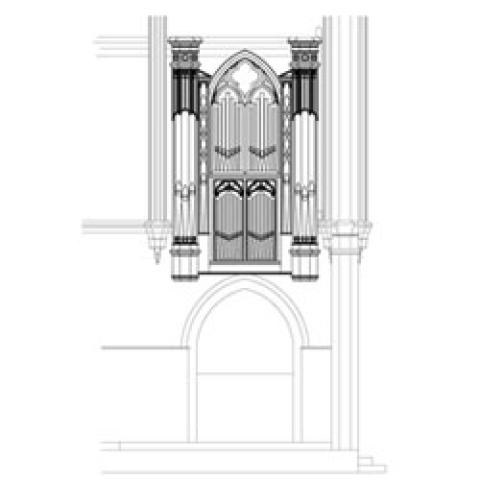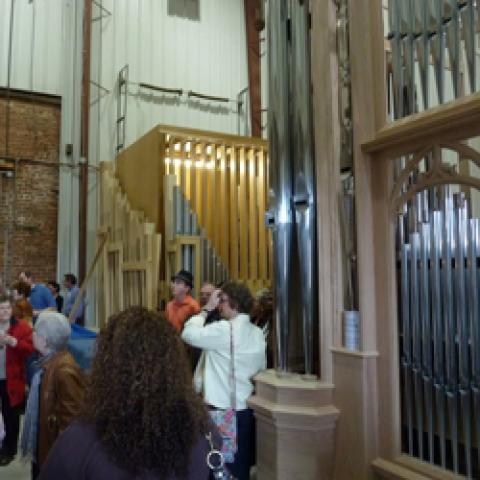Goulding & Wood Organ Builders, Inc., Indianapolis, Indiana
Opus 50
The Episcopal Church of the Good Shepherd, Lexington, Kentucky
From the organbuilder
“Worship the LORD in the beauty of holiness” could well serve as the motto for the organ project at the Episcopal Church of the Good Shepherd in Lexington, Kentucky. The Gothic revival building holds a wealth of architectural and design detail, culminating in an extravagance of carved furnishings in the chancel. Wainscot paneling in the sanctuary depicts scenes from the life of Christ, and the reredos displays a large tableau of the Last Supper.
Liturgical worship in the parish matches the opulence of the setting, with an unusually well-developed choral program encompassing all ages. Over the past twelve years, organist and choirmaster John Linker has built a music department known throughout the area for excellence. The Good Shepherd choirs have held residencies in English cathedrals and this summer made their first concert tour of continental Europe.
Throughout this period of musical expansion, the congregation has been served by a 1970s neo-Baroque organ of modest resources. Although the instrument was a fine example of its aesthetic approach and served the parish well for forty years, the organ was inadequate for the scope of the music program as it has evolved. It contained only one manual reed and no celeste rank. In short, the organ struggled to keep up with the demands of accompanying Anglican chant psalmody and the choral music of Stanford and Howells.
Conversation about replacing the organ began nearly a decade ago, yet while the need was never in dispute, external forces seemed to derail the discussion at every turn. Building on the foundation laid by Fr. Robert Sessum, interim rector Fr. Ron Pogue seized the opportunity during the time of transition in leadership to force the issue. The committee moved quickly under the focused leadership of chair Joseph Jones, and a contract was signed after a brief flurry of activity.
The organ is thus designed primarily as a handmaiden for musical liturgy in the Anglican tradition as it has been received by the American church. The instrument’s resources are uniquely tailored to the setting it serves in every regard. Recognizing the value of a wide tonal palette, the chancel instrument is double the size of the previous organ, gaining variety in tone rather than increase in volume. A new chamber was created by renovating a second-story storage room, allowing organ on both sides of the chancel for the first time. The existing chamber, formerly housing the Swell, now holds the Choir in intimate proximity to the voices it accompanies. The Swell resides within the new chamber, high in the chancel where its robust voice can speak freely into the room. The Great is divided in twin cantilevered cases facing each other, with the plenum stops on the cantoris side and color stops on the decani. Maximizing the versatility of this arrangement, the two halves of the Great can be silenced through individual Unison Off controls and coupled to the fourth manual separately. This allows, for instance, the Great principal cornet to dialogue with the Great Trumpet.
Early on, the committee determined that having a division in the back of the room would be a top priority. For all the storied choir-centric nature of the Anglican tradition, worship in America resoundingly seeks to involve the assembly in song. With the acoustically compromising arrangement of chancel chambers off the central axis of the room, an Antiphonal organ on the back wall would help unify music-making throughout the church. Whenever the issue of funding was raised, the Antiphonal division was widely recognized as the most palatable sacrifice, yet it remained a strong desire among the committee. Thanks to the efficacy of the fund-raising campaign and the generosity of the Miller and Wrigley families, the committee was able to avoid any limitations. Twin cases frame the majestic western lancet window, and the polished display pipes reflect the colorful light from the stained glass. The polished brass Festival Trumpet completes the visual effect with a regal touch.
Any student of organ design will recognize the predictable nature of stop lists from instrument to instrument across styles of organ building. The distinctive quality of tonal design lies in the careful specification of scales, mouth widths, and voicing techniques. All of these details are meticulously overseen by our head voicer, Brandon Woods, who works with each stop through design to final regulation in the room. In this he is ably assisted by David Sims, who contributes to each step of the process. This instrument features a weight in tone and variety in color consistent with the demands of accompanying voices in a sensitive, supportive manner. Each division includes an 8′ principal stop, each of varying volume and personality. The plenum choruses complement each other in combination as well as stand individually with integrity. As with many of our recent instruments, mouth widths below 1′ C on principal pipes are kept fairly narrow, allowing the upper lips of mouths to rise. This imparts a tone with generous fundamental development. With diapason chorus stops, this yields 8′ and 4′ stops with compelling and distinctive personalities. Higher-pitched stops and mixtures step back in scaling and broaden in mouth width to permit more upper partial development. Volume and speech are reserved in these stops, preventing them from dominating the texture. The result is a chorus with sheen but whose power comes from the fundamental.
The reed stops of the organ traverse a wide spectrum of musical effect. The Great Trumpet has lead resonators of generous scale and shallots with sharply tapered openings. These combine for a sound rich and heavy, blending into the principal chorus seamlessly. The Swell reed chorus features parallel openings on the shallots for a full-throated brilliance that pours from its chamber. The Choir’s Clarinet is gentle and voluptuous in the style of E. M. Skinner stops. The instrument is crowned by two solo reeds, the Choir Tuba and the Antiphonal Festival Trumpet. The Tuba is a typical high-pressure reed, in the style of Willis, with a broad, enveloping tone. The Festival Trumpet is commanding, speaking from its dramatic position, yet mild enough to use (sparingly) in chords.
Celeste ranks are of particular note in this organ. In addition to the ubiquitous strings in the Swell and Dulciana in the Choir, the Antiphonal contains a Diapason Celeste. Both unison and celeste ranks use slotted pipes to encourage the undulation, and the keen tone that derives from the slots makes for a distinctive sound. The timbre is unapologetically diapason in quality, and the vigorous sound of the two ranks together fills the room in a luxuriant wash of sound.
Windchests throughout the organ feature our unique electro-pneumatic slider and pallet design. The combination of tone channels running across stops and wholly pneumatic action enables the pipework to speak incisively yet without any harshness in attack. Further, the stops meld together as they draw wind from a common source. Arranging the mechanics and structure proved to be an extremely challenging task, particularly as the new Swell chamber’s dimensions continued to be a moving target throughout design and even construction of the organ. Staff design engineer Kurt Ryll and shop manager Mark Goulding nonetheless arrived at a layout that, if not commodious, certainly supports maintenance access to every component. Moving about the organ for routine tuning is remarkably simple, belying the complexity of the design necessary to achieve this.
The cabinetry of the organ and console was executed by Robert Duffy and Robert Heighway, culling elements from the room, such as the Tudor roses that adorn the rood screen and ornamental bosses featured in the reredos. The console uses marquetry to separate the divisions within the stop jambs and to frame the burled central panel of the music desk. Throughout the organ, both internal and visible details are finished with an attention to detail consistent with the quality of woodworking in the church.
The sum of all these disparate parts is an instrument that truly speaks forth, carrying the people’s song and supporting the choir in their leadership. While our intention was for it to be specifically suited to the worship of this congregation, we made no attempt to embody shallow or derivative notions of English organ building. This is an American instrument embracing the gamut of organ literature, hymnody, and choral music employed by the congregation. In realizing this goal we gratefully acknowledge the contributions of organist and choirmaster John Linker and committee chair Joseph Jones. We also recognize the steady leadership of the rector, Fr. Brian Cole, who inherited a project already underway and oversaw the completion with a dedication and enthusiasm as if it were his own. We look forward to sharing with the congregation in the upkeep of the organ, watching as it enlivens the worship at Church of the Good Shepherd and enriches the musical life of Lexington.
—Jason Overall
Goulding & Wood, Inc.
Indianapolis, Indiana
Robert Duffy, casework, cabinetry, and wood carvings
John Goulding, reed racking
Mark Goulding, shop foreman, general shop construction
Chris Gray, general shop construction
Robert Heighway, console cabinetry, casework cabinetry, and slider chests
Jerin Kelly, wind chests, general shop construction
Phil Lehman, office manager
Tyler MacDonald, wind chests
Jason Overall, office support and tonal design
Kurt Ryll, case design and engineering
David Sims, system wiring, tonal finishing
Michael Vores, structure, expression boxes, general shop construction
Brandon Woods, tonal design, voicing, and finishing.
From the organist & choirmaster
Goulding & Wood Opus 50 (named “The Miller and Wrigley Organ”) is the physical manifestation of many years of consideration, consultation, site visits, fundraising, and, of course, prayer. On my appointment to the Church of the Good Shepherd in 2001, it was immediately apparent that the previous neo-Baroque instrument had limited resources for accompanying the Anglican liturgy. As more and more electro-magnets and memory capture components failed, it was decided to replace the instrument with an organ more suitable to the fine Gothic architecture of Good Shepherd, and having a more diverse tonal palette, rather than to restore the previous instrument.
Upon his retirement in 2009, former rector Fr. Robert Sessum suggested to the congregation that the next project in the immediate future of Good Shepherd should be to replace the organ. The congregation heeded the advice of Fr. Sessum, and over the next two years an organ committee and organ capital campaign committee were formed under the guidance of the interim rector, Fr. Ron Pogue. Our new rector, Fr. Brian Cole, oversaw installation of the new instrument. It is a privilege to have worked with these three clergymen in seeing the dream of a new instrument for Good Shepherd come true.
In selecting a builder, the committee had their work cut out for them. My personal preference favors mechanical action, as I have found tracker instruments to be superior tools of artistic expression. Early on in the process, however, our committee had to dismiss this as an option due to Good Shepherd’s architecture and our desire to have symmetrically balanced cases on both sides of the chancel, as well as an Antiphonal division at the west end to better support hymn singing. After reviewing numerous designs, specifications, and participating in site visits, the committee unanimously chose Goulding & Wood.
Over many months we worked closely with Goulding & Wood president Jason Overall and head voicer Brandon Woods on a specification that would meet Good Shepherd’s liturgical needs and be unique. We agreed to reuse some of the finest pipework from the old instrument in the new organ. The former Great 8′ Principal and 4′ Octave were revoiced and now reside in the Choir as 8′ Open Diapason and the 4′ Principal. The former 16′ Subbass (which was, in fact, from the parish’s Pilcher organ from the 1920s) was revoiced and at home again in Good Shepherd. The Pedal 4′ Schalmey as well as the Zimbelstern were also worthy of recycling.
As its primary function is to accompany the Anglican liturgy, a complete and powerful Swell division is a must. The new Swell boasts a complete principal chorus, luscious strings, and harmonic flutes at 4′ and 2′ pitches, as well as a full complement of 16′ through 4′ reeds. While the Swell, Choir, and Pedal divisions appear fairly standard in specification, it is the Great and Antiphonal divisions that have the most innovative design and function. The Great is divided on both sides of the quire, and as such, each side can be coupled separately to the fourth manual to solo out melodies of hymns or other innovative uses. In addition to having a complete principal chorus, the Antiphonal also boasts a “Diapason Celeste.” While a Voce Umana or a Fiffaro might be common in Italian organs, a stop such as this is rarely found on English-inspired American organs. Furthermore, this stop is indeed an open, full-bodied, English-style Diapason. Though its use in repertoire is extremely rare (it is likely not the sound Frescobaldi had in mind!), it is incredibly useful in improvisations. The sound of this celeste is rich and embodying. Indeed, the entire instrument draws a new level of musicality and creativity from those fortunate to play it, and it is the prayerful congregant who receives the greatest benefit.
The people of Good Shepherd take great pride in our choir program, which has attained a high degree of international recognition over the past decade. Attention to and participation in congregational hymn singing is now at an all-time high for this parish. Now that this glorious instrument is in place, matching the beauty of the choir, the architectural environment, and the mighty singing of the congregation, we eagerly anticipate reaching new heights in our spiritual and musical journeys, and discovering new ways in which we are all able to see glimpses of heaven right here on earth.
—John Linker
From the organ committee
The organ committee consisted of a cross-section of the congregation, Dr. Schuyler W. Robinson, professor of organ at the University of Kentucky, and our church organist/choirmaster. The committee’s charge was to determine the type, size, and placement of the future instrument, and to set the budget. Its most important task was to find the perfect fit between the church and the company selected to build the instrument. The committee hired a consultant to help it identify the best North American organ builders, and we invited five of them to Lexington to present preliminary designs and cost estimates for the project. The committee then sent our two organists to play instruments representative of each builder.
After careful deliberation, we chose Goulding & Wood of Indianapolis. Their plan was exciting and seemed to fit our needs perfectly. When the instrument was ready for installation, Goulding & Wood issued an invitation to the congregation to come to their workshop in Indianapolis to hear the organ before their team dismantled it and began to transfer it to Lexington. A few weeks later, the first pipes arrived and were paraded into the nave of the church, led by our bagpiper, and were blessed during a short service. The new and exciting musical voice of the Church of the Good Shepherd is a dream come true.
—J. R. Jones
Organ Committee Chair
From the rector
One of the real gifts of the Episcopal/Anglican tradition is the ability to keep a healthy tension between tradition and change. At Good Shepherd, the arrival of Goulding & Wood Opus 50 (the “Miller and Wrigley Organ”) is a fine example of that gift.
The builders from Goulding & Wood were very sensitive to the change that takes place when an instrument like this is placed in an historic space. Throughout the weeks of building on site, we welcomed parishioners and community members to visit our church during construction. Numerous photographs and videos, both formal and informal, were taken to record the work. Even though the builders were guests to our space, they served as good hosts, as long-time members and newcomers asked questions while the installation process unfolded.
Now that it is in place, the organ appears to have always been in our liturgical space. The antiphonal division now frames the glorious Abbott Window in the rear of the church and accentuates the colors of the stained glass. The new organ has also already been a catalyst for more vigorous congregational singing. The old organ console has been refashioned to make a smaller altar for our Sunday evening Eucharist.
We are all blessed to be a part of Good Shepherd’s story at this time. The Miller and Wrigley Organ, while new, affirms the great strengths of traditional Anglican worship. Because of its incredible versatility, this instrument will serve as an anchor as we expand the musical life of the parish in arts offerings to the Lexington community.
—The Rev’d Brian Cole




